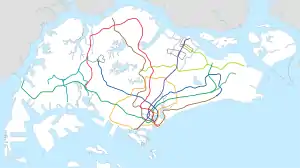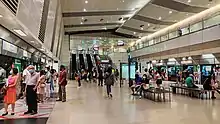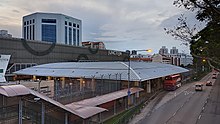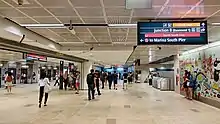Bishan MRT station
Bishan MRT station is a Mass Rapid Transit (MRT) interchange station on the North South (NSL) and Circle (CCL) lines in Bishan, Singapore. Located along Bishan Road within the town centre area, it is integrated with the Junction 8 shopping centre and close to the Bishan Bus Interchange. Nearby schools include Raffles Institution and the Kuo Chuan Presbyterian Primary and Secondary Schools.
NS17 CC15
Bishan 碧山 பீஷான் Bishan | ||||||||||||||||
|---|---|---|---|---|---|---|---|---|---|---|---|---|---|---|---|---|
| Mass Rapid Transit (MRT) station | ||||||||||||||||
 Exit A of Bishan station. | ||||||||||||||||
| Location | 200 Bishan Road Singapore 579827 (NSL)[1] 17 Bishan Place Singapore 579842 (CCL)[2] | |||||||||||||||
| Coordinates | 1°21′04″N 103°50′54″E | |||||||||||||||
| Owned by | Land Transport Authority | |||||||||||||||
| Operated by | SMRT Trains Ltd (SMRT Corporation) | |||||||||||||||
| Line(s) | ||||||||||||||||
| Platforms | 4 (1 island platform, 2 side platforms) | |||||||||||||||
| Tracks | 4 | |||||||||||||||
| Connections | Bus, Taxi | |||||||||||||||
| Construction | ||||||||||||||||
| Structure type | Subsurface (North South line) Underground (Circle line) | |||||||||||||||
| Platform levels | 2 | |||||||||||||||
| Parking | Yes (Junction 8) | |||||||||||||||
| Disabled access | Yes | |||||||||||||||
| History | ||||||||||||||||
| Opened | 7 November 1987 (North South line) 28 May 2009 (Circle line) | |||||||||||||||
| Rebuilt | 27 July 2008 (North South line southbound platforms) 22 May 2009 (North South line northbound platforms) | |||||||||||||||
| Electrified | Yes | |||||||||||||||
| Previous names | Kampong San Teng,[3] San Teng[4][5] | |||||||||||||||
| Passengers | ||||||||||||||||
| July 2020 | 11,367 per day[6] | |||||||||||||||
| Services | ||||||||||||||||
| ||||||||||||||||
| Location | ||||||||||||||||
 Bishan Bishan station in Singapore | ||||||||||||||||
Initially announced as Kampung San Teng, it was later named San Teng and subsequently Bishan. Opened on 7 November 1987, Bishan NSL station is one of the first five stations on the MRT network. During the construction of the CCL station, the original island platform of the NSL was split into two separate side platforms and the station was upgraded to cope with increased passenger traffic from the CCL, which opened on 28 May 2009. In 2017, a major flooding occurred in the tunnels between this station and Braddell station, disrupting train services on the NSL. Bishan is the only ground-level station on the network, and features Move! by Soh Ee Shaun as part of the network's Art-in-Transit programme.
History
North South line (1987)
Bishan station (then Kampung San Teng) was one of the first stations to be included in the planning stages of the MRT network.[7] The station was later renamed to San Teng in November 1982[3] and would be built in a Chinese cemetery.[8]
Contract 103 for the construction of San Teng MRT station and 3.2-kilometre (2.0 mi) of tunnels between the San Teng and Braddell stations was awarded to a Belgian and Singaporean joint venture (Hytech, Franki and Compagnie Francois d'Enterprises) in December 1983 at a contract sum of S$32.88 million (US$15.56 million). This was the first contract involving cut and cover construction awarded by the MRT Corporation (MRTC).[9] On 21 September 1984, the MRT Corporation renamed San Teng station to Bishan station to reflect the name of the new housing estate that was being built around this MRT station.[4][10]
Structural works for Bishan station was completed on 23 October 1985.[11] In January 1986, it was announced that the first section of the MRT system, from the Yio Chu Kang to Toa Payoh stations, would be opened in early 1988.[12] It was later announced in September 1987 that the section will open on 7 November that year.[13][14] As an effort for people to get familiar with the system, the station was opened for a sneak preview from 24 to 25 October.[15][16] As announced, the station was one of the first MRT stations on the network to be opened for service on 7 November 1987.[17]
Circle MRT line and further upgrades (2008-09)

Contract C825A for the design, construction and completion of Bishan interchange station was awarded to Econ Corporation Ltd and Eng Lim Construction Co Pte Ltd Joint Venture[18] at a sum of S$82.2 million (US$47.19 million) in July 2003. The contract also includes the upgrading of the NSL station. Construction was targeted to start in the third quarter of 2003 and was expected to be completed by early 2008.[19][20]
The original NSL station underwent major alterations. A new air-conditioned platform to serve southbound trains to Marina South Pier was constructed to increase the passenger capacity of the station from 1,250 to 2,020. The new platform, Platform B, opened for service on 27 July 2008. The station was expanded to handle increased passenger traffic when the CCL station opens.[21] As the original platform, now serving northbound trains to Jurong East, remained in service, upgrading works for the platform (Platform A) was hindered and took about a year to complete. While the re-tiling of the platform was done during the day, the Platform Screen Doors (PSDs) were installed in sections through the night. An air-conditioning system was also installed as part of the upgrade. Upgrading works for the platform were fully completed on 23 May 2009. An additional entrance to the basement of Junction 8 was also built.[22] Along with the other Stage 3 CCL stations, the CCL station were opened on 28th of that month.[23][24]
Due to the close proximity of a nearby tunnel portal to residential apartment blocks, the installaton of the 2-metre (6.6 ft) tall barriers stretching 180 metres (590 ft) in length started in September 2011 and was completed by the second quarter of 2012. It is insulated with noise absorptive materials such as rock wool, which helped reduce noises by about 5 decibels.[25][26][27] The NSL station underwent another upgrade in 2016 with the repositioning of seats at the platforms to allow more space and seats for commuters.[28]
Incidents and accidents
On 28 July 2004, a 31 year old accountant died after falling on the track in front of an oncoming train at this station, disrupting train services on the northbound MRT line for an hour.[29][30] Another such incident happened to an elderly man on 15 September that year.[31]
On 7 October 2017, water got into a section of the tunnel between Bishan and Braddell MRT stations during a heavy downpour in the afternoon, which disrupted train services along 13 stations on the North South line for several hours. This case of water entering MRT tunnels is believed to be the first time it has affected train service along the NSL. Separately, at about 5.55 pm, a small fire was spotted trackside in the tunnel between the Marina Bay and Raffles Place stations, but it had died down by itself. It is not clear if it is linked to the flood, although electrical short circuits caused by water had sparked tunnel fires before.[32][33] Train services between Marina South Pier and Newton were restored on the day itself at about 9.20 pm. Train services between Newton and Ang Mo Kio were fully resumed at 1.36 pm the following day after overnight efforts to clear the water in the tunnel, after nearly 21 hours of service disruption, being one of the worst disruptions in SMRT's history.[34] It was revealed that the overflowing in the tunnel was caused by a malfunction in the water pumping system, which has since been repaired.[35]
Station details
Location and name
Track layout for NSL platforms | |||||||||||||||||||||||||||||||||||||||||||||||||||||||||||||||||||||||||||||||||||||||||||
|---|---|---|---|---|---|---|---|---|---|---|---|---|---|---|---|---|---|---|---|---|---|---|---|---|---|---|---|---|---|---|---|---|---|---|---|---|---|---|---|---|---|---|---|---|---|---|---|---|---|---|---|---|---|---|---|---|---|---|---|---|---|---|---|---|---|---|---|---|---|---|---|---|---|---|---|---|---|---|---|---|---|---|---|---|---|---|---|---|---|---|---|
| |||||||||||||||||||||||||||||||||||||||||||||||||||||||||||||||||||||||||||||||||||||||||||
As the name suggests, the station is located in Bishan along Bishan Road. The name Bishan is the Mandarin pronunciation of Peck San (Chinese: 碧山; pinyin: bìshān).[36] The name, in turn, was derived from the name of a large Cantonese burial ground Peck San Theng that used to cover the area.[37]
The station is situated near the retail development of Junction 8 and other public amenities such as the Bishan Public Library, CPF building, Bishan Neighbourhood Police Post, Bishan Stadium, Bishan Community Club and the Bishan Bus Interchange. It is also within walking distances to the schools of Raffles Institution, Kuo Chuan Presbyterian School and the Ministry of Education Language Centre.[38]
Services
The station serves the North South (NSL) and Circle lines (CCL). The station code is NS17/CC15 as reflected on official maps.[39] On the NSL, the station is located between the Ang Mo Kio and Braddell stations, while on the CCL, the station is located between the Lorong Chuan and Marymount stations.[39] NSL have headways of 2 to 5 minutes, while the CCL services have headways of 3.5 to 5 minutes.[40]
Design

The NSL station is the only ground-level MRT station on the network.[41] The station was designed to have an "open, sunken-plaza" concept allowing natural light on the tracks.[42] The station has a beige and brick coloured scheme with bougainvillaeas planted outside the station.[43] The station concourse has a steel roof cladding supplied by Robertson Building Systems (RBS) through a S$20 million (US$9.09 million) contract.[44] During the construction of the CCL, the entrance was upgraded with the intention to "capture the essence" of the station being a "gateway" to Bishan. It now features a "pyramidal" opened-top aluminium roof over the existing flat roof which allows sunlight and ventilation into the station.[45]
The retail stores around the station use glass panels which chamfered at the corners of the station, giving balance to the roof. The glass walls are separated from the roofline via a small space at the top such that the roof appears afloat. The paid area is kept spacious with a layered ceiling and design elements made of glass. A glass canopy connects the station to the retail development of Junction 8.[45]
Bishan CCL station is one of eleven stations along the Circle line designated as Civil Defence (CD) shelters, which will be activated in times of national emergency. Apart from reinforced construction, the stations are designed and equipped with facilities to ensure the shelter environment is tolerable for all during shelter occupation. These facilities include protective blast doors, decontamination facilities, ventilation systems, power and water supply systems and a dry toilet system.[46]
Move!

An artwork Move! by Soh Ee Shaun is displayed at the CCL station as part of the network's Art-in-Transit programme.[lower-alpha 1] The artwork consists of three murals - The Family, The Scientist and The Heartland - made of 16 glass panels each cast in film.[47] The artwork reflects the artist's view on the "mindless rush of commuters" through the station.[48][49] The Family, a 3-by-8.7-metre (9.8 by 28.5 ft) mural mainly in yellow and black, depicts ordinary activities part of Singapore's "air-conditioned" lifestyle, while The Scientist portrays "larger-than-life" scientists surrounded by a gallery of modern technology such as rockets, robots and fighter jets in blue and black on a 3-by-7.2-metre (9.8 by 23.6 ft) canvas. The Heartland, on a 2.9-by-8.2-metre (9.5 by 26.9 ft) panel, represents the neighbourhood of Bishan, with notable landmarks of the neighbourhood against the pink backdrop.[49]
The artist was one of the youngest artists for the CCL artworks and was picked for Bishan as it was believed his dynamic drawings would be engaging to the youth and families in the town.[50] Soh initially planned to create an abstract work of people moving around to reflect the bustle of a train station. However, it was thought to be "too literal" and the curator Karen Lim, who was guiding the artist in his work, urged Soh to include thematic stories into the work.[49]
Hence, each of the three art walls he was assigned to adopted a subject matter. Soh did not manage to find inspiration from his first visit to Bishan and instead drew up murals centred on general life in Singapore – Garden Circus, The Control Room and The Living Room. The latter two developed into The Scientist and The Family respectively. For Garden Circus, however, which illustrates the "pace of life" in Singapore, was pulled out as it was considered "not strong enough conceptually".[51] To overcome the mental block, the artist made another trip to Bishan and found inspiration for The Heartland. These artworks, although using different subject matters, adopts the artist's "silly and illogical" style with his illustrations. Usually, Soh's drawings are spontaneous, with the concepts produced "as an afterthought". In this work, however, Soh first drew up various drafts and worked out how to fuse the different parts into the final product. Being aware that his work will be a long-term feature in the station, Soh heavily considered what he was going to illustrate so that his work would remain relevant throughout time.[51]
The work was subsequently reproduced digitally and enlarged to fit on the walls. Soh inspected each of the panels shipped from overseas and oversaw the installation of his work in the station with the cooperation of the station architects and production team. As a tribute to them, the artist inserted workers with construction hats on The Heartland.[51] Soh was grateful for the guidance from the curator, as this was one of his first major works ever since he started drawing seriously two years ago. The curator had suggested to the artist to "tone down" his murals so as to avoid the viewers being "drawn away" from the narratives. Lim also guided the artist when to pause as Soh kept inserting more features and altering the work. Soh reflected that this work allowed him to mature as an artist, and hoped that the work will "liven up" the plain environment of the station and provide something fresh to the commuters and brighten up their day.[50]
Art Seats

In addition to the murals, the CCL station features two sets of Art Seats, designed to enhance the commuters' experience on the line.[52] Two entries were selected through the International Art Seats Design Competition in 2006. The first entry – Matrix, which received the top prize in the international competition, consists of a series of benches engraved with the station name in a dot-matrix style on the seat surface. The dot-matrix system was used as it was flexible enough to be used across stations and could be mass-produced. Another entry, Rain, showcases steel seats in the shape of water puddles, unlike the ordinary solid and stone seats in other MRT stations.[lower-alpha 2][53]
Cultural impact
Being located on the former burial site of the Peck San Theng, the station was rumoured to be haunted. In response to the calls and letters from light-night passengers claiming to witness headless ghosts at the station, The New Paper went to investigate in October 1988 but did not uncover any ghosts. Interviewing the MRTC, the operator has said the operations and their staff have not been impacted by any alleged "sightings", although it confirmed the station was at the site of the former cemetery.[54]
In April 2005, The Straits Times investigated and debunked several accounts of ghosts at the station. One account mentioned being in a late-night train which did not stop at the station. When the passenger confronted the driver, the driver claimed to see 50 people at the station, while the commuter had seen only 10 to 15 of them. The operator, now SMRT Trains, confirmed that trains do bypass stations sometimes, although usually these trains are empty. The operator added that the train could have bypassed the station when it failed to stop at the station "due to a technical fault".[55]
The station was well-known with its tales of headless figures alighting and boarding at the station, with one version mentioning about a ghost sitting in the last car with its decapitated head on the adjacent seat. Such tales likely originated from the Kwong Wai Siew Peck San Theng columbarium, which now houses 45,000 urns, according to the Singapore Paranormal Investigators (SPI).[lower-alpha 3] The article also mentioned a first-hand account by a former civil servant who claimed to have passed out while taking the train in 1991. She claimed to have felt many groping hands before fainting after the train pulled out of Bishan station.[55] In a field investigation, The Straits Times reported no encounters of any ghosts.[55]
Notes and references
Notes
- Public art showcase which integrates artworks into the MRT network
- These seats are also displayed in the other CCL interchange stations, such as Buona Vista and Dhoby Ghaut stations.
- A group that researches on the supernatural
References
- "Location View of 200 Bishan Road, 579827". www.streetdirectory.com. Archived from the original on 7 January 2021. Retrieved 23 April 2020.
- "Bishan (MRT Station) - 17 Bishan Place (S)579842". www.streetdirectory.com. Archived from the original on 7 January 2021. Retrieved 23 April 2020.
- "Station names will reflect their localities". The Straits Times. 30 November 1982. Archived from the original on 7 January 2021. Retrieved 29 December 2020.
- "Six stations are renamed and others moved". The Straits Times. 21 September 1984. p. 10. Archived from the original on 31 May 2016. Retrieved 24 April 2016.
- "Names for 42 MRT stations". Singapore Monitor. 20 September 1984. Archived from the original on 9 September 2020. Retrieved 23 April 2020.
- "Land Transport DataMall". mytransport.sg. Archived from the original on 21 August 2020. Retrieved 20 August 2020.
- "Proposed MRT stations". The Straits Times. 23 May 1982. p. 1. Archived from the original on 9 December 2020. Retrieved 12 December 2020.
- "Where the 14 North-South MRT stations will be". The Straits Times. 30 November 1982. Archived from the original on 7 January 2021. Retrieved 29 December 2020.
- "Two MRT contracts worth $96m awarded". The Straits Times. Singapore. 16 December 1983. Archived from the original on 7 January 2021. Retrieved 30 December 2020.
- "MRT Corp changes names of six stations". Business Times. 21 September 1984. Archived from the original on 7 January 2021. Retrieved 29 December 2020.
- "Topping out for MRT station at Bishan". Business Times. 23 October 1985. Archived from the original on 7 January 2021. Retrieved 30 December 2020.
- "The first residents to ride MRT trains". The Straits Times. 14 January 1986. p. 12. Archived from the original on 19 December 2020. Retrieved 19 December 2020.
- "MRT trains to roll on Nov 7". The Straits Times. 16 September 1987. p. 1. Archived from the original on 19 December 2020. Retrieved 19 December 2020.
- "MRT trains may start runs a month early". Business Times. 16 September 1987. p. 2. Archived from the original on 19 December 2020. Retrieved 19 December 2020.
- "MRT to spend $1.5 m on educating public before trains roll". Business Times. 25 September 1987. p. 2.
- "Two small buttons to stop train in emergency". The Straits Times. 24 October 1987. Archived from the original on 7 January 2021. Retrieved 30 December 2020.
- "All aboard for the Subway Age". The Straits Times. 8 November 1987. Archived from the original on 12 September 2017. Retrieved 3 February 2020.
- "Projects - Rail". www.lta.gov.sg. 5 August 2008. Archived from the original on 6 August 2009. Retrieved 19 June 2020.
- "Award Of Contracts For Stage 3 Of Circle Line". www.lta.gov.sg. 31 July 2003. Archived from the original on 6 August 2008. Retrieved 19 June 2020.
- "$313m Circle Line contracts awarded". The Straits Times. 1 August 2003. p. 10.
- "New Platform at Bishan Station ready". The Straits Times. 26 July 2008.
- "Bishan MRT station ready for Circle crowds". The Straits Times. 22 May 2009. p. 49.
- "Circle Line to open 2 days ahead of schedule, fares identical to NEL". Channel NewsAsia. 16 April 2009. Archived from the original on 17 April 2009. Retrieved 16 April 2009.
- "Early Opening for Circle Line from Bartley to Marymount" (PDF). www.lta.gov.sg. Archived from the original (PDF) on 21 February 2013. Retrieved 16 April 2009.
- "LTA to study noise levels along elevated MRT tracks". Channel NewsAsia. 14 June 2011. Archived from the original on 15 June 2011. Retrieved 14 June 2011.
- "LTA Unveils Plans To Look Into Mitigating Railway Noise". www.lta.gov.sg. 14 June 2011. Archived from the original on 8 February 2016.
- "LTA to Install Railway Noise Barriers at Tampines, Jurong East and Toh Guan". www.lta.gov.sg. 16 October 2012. Archived from the original on 8 February 2016.
- "17 MRT Stations to be Upgraded". www.lta.gov.sg. 19 October 2015. Archived from the original on 22 October 2015. Retrieved 6 January 2021.
- "Bishan MRT Death". The New Paper. 29 July 2004.
- Teck Hian, Wee (29 July 1994). "Death at Bishan Station disrupt services". Today.
- "MRT incident hits services". Today. 16 September 2004. Archived from the original on 7 November 2017.
- "Water in the tunnel, trackside fire caused train disruption on NSL: SMRT". Channel Newsasia. 8 October 2017. Archived from the original on 7 October 2017. Retrieved 8 October 2017.
- "NSL disruption: Train services between Ang Mo Kio and Newton will not be available until earliest Sunday". The Straits Times. 7 October 2017. Archived from the original on 7 October 2017. Retrieved 8 October 2017.
- "NSL disruption: No train services between Ang Mo Kio, Newton 'till further notice', says SMRT". Channel NewsAsia. Archived from the original on 8 October 2017. Retrieved 8 October 2017.
- "NSL disruption: Malfunctioning water pumping system resulted in flooded MRT tunnel, says LTA". Channel NewsAsia. Archived from the original on 8 October 2017. Retrieved 8 October 2017.
- Ng 2018, p. 89.
- Savage 2013, p. 40.
- "SMRT Journeys". SMRT Journeys. Archived from the original on 7 January 2021. Retrieved 6 January 2021.
- "MRT System Map" (PDF). Land Transport Authority (LTA). Archived (PDF) from the original on 21 August 2020. Retrieved 23 August 2020.
- "Transport Tools - MRT/LRT". www.lta.gov.sg. 6 May 2020. Archived from the original on 1 November 2019. Retrieved 19 June 2020.
- "First MRT line mostly subway". The Straits Times. 13 October 1982. Archived from the original on 7 January 2021. Retrieved 7 January 2021.
- Rav Dhaliwal (1 March 1987). "Rainbow dressing at Toa Payoh station". The Straits Times. p. 3.
- "Reflections of our lifestyle". The Straits Times. 12 December 1987. Archived from the original on 10 September 2020. Retrieved 19 December 2020.
- "RBS to provide Bishan station with roof cladding". Business Times. 30 April 1985. p. 3. Archived from the original on 7 January 2021. Retrieved 6 January 2021.
- "Circle Line Bishan Interchange Station CC15/ NS17 - SAA Group Architects". SAA Group Architects. 2 November 2019. Archived from the original on 2 November 2019. Retrieved 6 January 2021.
- Colin 2012, p. 176.
- "Bishan Circle Line Artwalls". www.gardensilly.com. Archived from the original on 7 January 2021. Retrieved 6 January 2021.
- Massot, Gilles (7 April 2020). "Getting Around - Public Transport - A Better Public Transport Experience - Art in Transit". www.lta.gov.sg. Archived from the original on 21 April 2020. Retrieved 21 April 2020.
- Zhuang, p. 98.
- Zhuang, p. 101.
- Zhuang, p. 100.
- "Singapore Built & Unbuilt". www.mci.gov.sg. Archived from the original on 18 August 2020. Retrieved 18 August 2020.
- Zhuang 2013, p. 188–193.
- Abdul Hadhi (17 October 1988). "Where are the ghosts?". The New Paper. p. 3. Archived from the original on 11 June 2016. Retrieved 13 May 2016 – via NewspaperSG.
- Mun San, Mak (17 April 2005). "Is Bishan MRT 'unclean'?". The Straits Times. p. 4. Archived from the original on 11 June 2016. Retrieved 14 May 2016 – via NewspaperSG.
Further reading
- Ng, Yew Peng (2018). What's in the name? How the streets and villages in Singapore got their names. Singapore: World Scientific. ISBN 978-981-322-139-0. OCLC 990571127.
- Savage, Victor (2013). Singapore street names : A study of Toponymics. Singapore: Marshall Cavendish Editions. ISBN 978-981-4408-35-6. OCLC 868957283.
- Zhuang, Justin (2013). Art in transit : Circle Line MRT - Singapore. Singapore: Land Transport Authority. ISBN 978-981-07-4982-8. OCLC 854958677.
- Colin, Cheong (2012). The Circle Line, Linking All Lines. ISBN 978-981-4342-02-5.
External links
- Official website
 Media related to Bishan MRT Station at Wikimedia Commons
Media related to Bishan MRT Station at Wikimedia Commons
.jpg.webp)
.jpg.webp)
